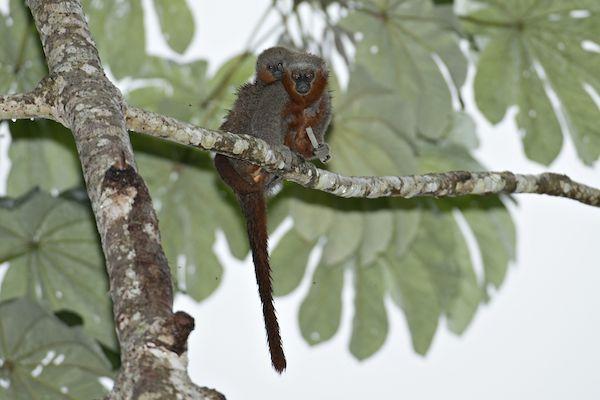Best estimates put the number of pygmy elephants in Malaysian Borneo at approximately 2,200, but no one can be sure how many have lost their lives in recent years as palm plantations encroach further and further into the rainforest. What is clear is that if the loss of their forest habitat continues to drive conflicts with humans at the rate it is now, Borneo elephants’ long-term survival may be in jeopardy.
There have been several high-profile cases, like the 14 elephants that were poisoned last year in Sabah Province, where the majority of Borneo elephants live and where deforestation has claimed huge amounts of forest over the past half-century. More recently, Sabah was the scene of a grisly shooting death of yet another elephant.
Borneo elephants (Elephas maximus borneensis) are listed by the IUCN as Endangered, living almost entirely in Sabah (approximately 80 also live in northern Kalimantan). A subspecies of the Asian elephant, Borneo elephants – also called Borneo pygmy elephants – are similar in size to their counterparts in peninsular Malaysia, and are threatened primarily by habitat loss.
Malaysia tops Indonesia, Brazil, and Nigeria as the country with the world’s highest rate of deforestation. According to Global Forest Watch, the country lost more than 500,000 hectares of forest in 2012 alone. Sabah, the smaller of Malaysia’s two Bornean states, lost nearly 900,000 hectares of forest between 2001 and 2013 – or about 15 percent of its tree cover. Constricted habitat driven in large part by palm oil expansion is squeezing elephants out of forests and into areas inhabited by humans, leading to increasing rates of human-elephant conflicts and subsequent elephant killings.
There has been more than one case of baby elephants being found alone, orphaned, starving, and dehydrated. It is highly unusual for a mother elephant to abandon her children, so there’s a good chance the mothers were killed and their bodies never discovered. In fact, it’s likely that there are far more elephant deaths than we ever hear about.
“It would be hard for anyone to know how many died,” Cynthia Ong, executive director of LEAP (which stands for Lands Empowerment Animals People) told mongabay.com. “We know that some died. Maybe even many died. Some perhaps got shot and got buried and no one ever knew.”
The deaths we do know about mostly appear to have been deliberate, retaliatory killings after the elephants entered fields and ate or trampled crops. Not everyone has a problem with the elephants—many Indigenous people call them “Nenek,” which means grandmother in Malay, and are happy to peacefully cohabitate with them. Ultimately, the main driver of human-elephant conflicts in Malaysian Borneo is deforestation for new palm plantations, which leads to elephant habitat loss through fragmentation of forest—and of the government bodies responsible for ensuring the health and safety of the people, the forests, and the wildlife of Malaysian Borneo.
Elephants travel in herds across long migration routes, so as palm plantations proliferate, conflicts are becoming more frequent and more intense. And while there are efforts to preserve at least some of the elephants’ habitat, these are often isolated pockets of intact forest increasingly surrounded by monocrop plantations (this is what it means for the forest to be fragmented). As a result, elephants and people are competing for resources. When they can’t find food in their natural habitat, elephants may go into palm or fruit plantations to find a meal.
It’s a complex problem, one that requires an equally complex solution. But Cynthia Ong does not think the solution is going to come from the state, at least not without a lot of help from civil society and the public.
“You have the forestry department, and the wildlife department, and the land department. And almost ne'er the twain shall meet,” she says. “The way they run historically is as little kingdoms of their own. That fragmentation does not bode well for us to find solutions that are holistic. But we’re working on it.”
While civil society tries to bring together all stakeholders to come up with solutions that match the enormity of the problem, some efforts are being made to protect elephants directly.
According to researchers Benoit Goossens, Nurzhafarina Othman, Nurzhafarina Othman, Senthilvel Nathan, and Marc Ancrenaz, some 60 elephants were moved onto Managed Elephant Ranges (MERs) between 2010 and 2014 after they were deemed threats to palm plantations and human settlements.
But Goossens and his colleagues also believe that while translocation of “problem” elephants is the quickest way to defuse the immediate situation, it is a costly process and can have just as big an impact on the social structure of a herd as violent killings. Individuals in a herd “depend on each other for protection and direction,” the researchers said in a statement to mongabay.com, adding that “removal of some individuals will create confusion for the others and could jeopardize the behavior and survival of these elephants.” They pointed to one case in which wildlife rangers who were monitoring a group of elephants after a mass killing reported larger group sizes and more aggressive reactions from some individual elephants when they encountered people.
Even the sanctity of Managed Elephant Ranges is not guaranteed. According to Goosens and his colleagues, some 261,264 hectares of the Central Sabah Range is subject to a multiple-use forest management model, which allows for a variety of developmental activities, including more palm plantations.
“A major shortfall of the project is that it is developing a new land-use plan without considering the need to sustain long-ranging species like the elephant,” they said. “This situation will result in increased conflicts, possibly increased elephant mortality and increased financial losses.”
In the end, all of the stresses human development is putting on Borneo elephant populations run the risk of altering their behavior permanently, making them not just cautious of humans but outright aggressive. If that is to be the case, the vicious cycle of human-elephant conflict will keep going round and round, until the political will is summoned to enact true solutions for people and elephants alike.
This article was originally written and published by Mike Gaworecki, a news correspondent for news.mongabay.com. For the original article and more information, please click HERE.




